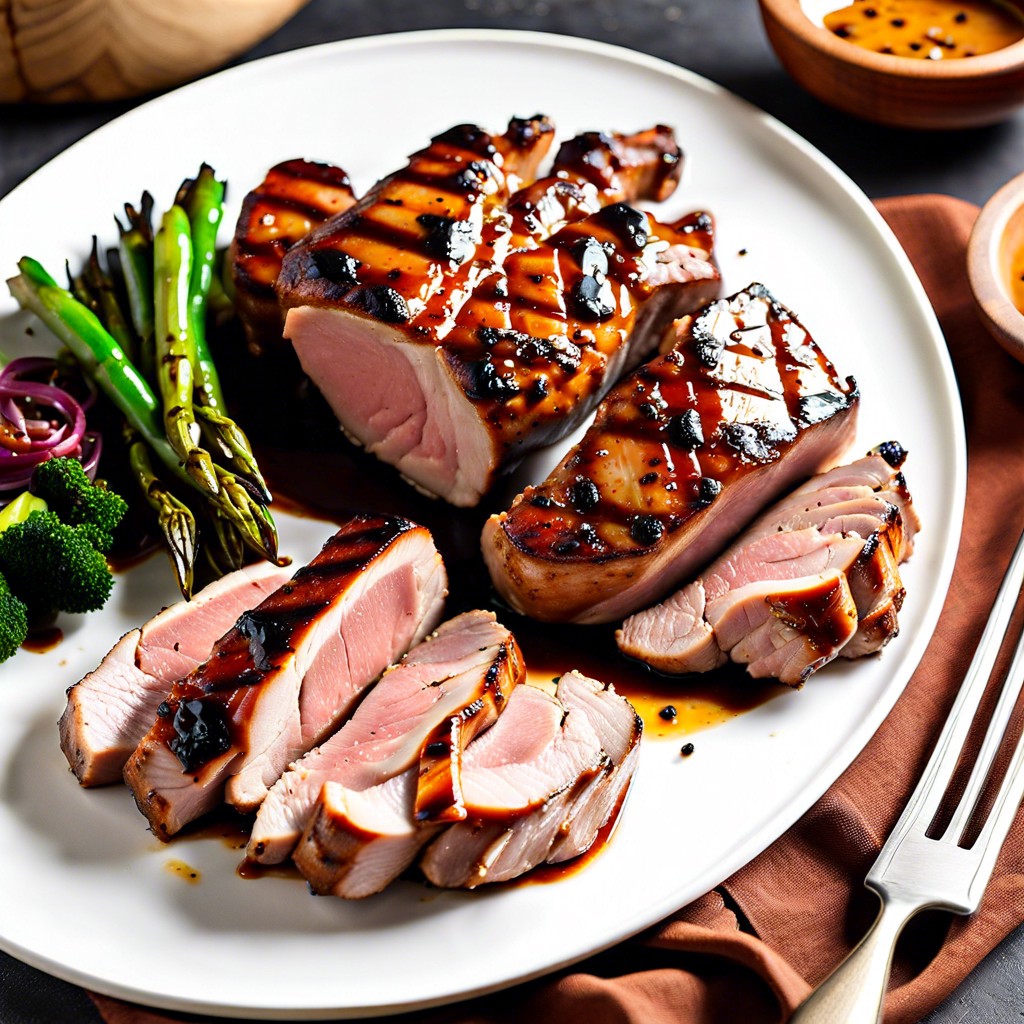Learn how to master the art of grilling pork tenderloin for a juicy, flavorful meal with optimal cooking techniques and seasoning tips.
Key takeaways:
- Understand the difference between pork tenderloin and pork loin.
- Properly trim the silver skin from pork tenderloin.
- Grill the pork tenderloin using indirect heat and monitor temperature.
- Add a spice rub before grilling for added flavor.
- Allow the pork tenderloin to rest before slicing to retain juiciness.
Pork Tenderloin Vs. Pork Loin

Understanding the distinction between tenderloin and loin is crucial for grilling success.
Pork tenderloin, the muscle that runs along the backbone, is renowned for its tenderness and quick cooking time due to its leanness.
In contrast, pork loin, a larger, fattier cut often sold with the bone in, requires a longer time on the grill to reach proper doneness.
For optimal grilling, selecting pork tenderloin translates to a more delicate texture and a shorter, more attentive cooking process to avoid over-drying.
How to Trim Silver Skin From Pork Tenderloin
Proper trimming is crucial to achieving a tender, flavorful result when grilling pork tenderloin. The silver skin, a thin sheath of connective tissue, doesn’t break down during cooking and can be tough and chewy.
First, pat the meat dry with paper towels to enhance grip. Place the tenderloin on a cutting board and identify the silvery-white layer on the surface. Lift a corner of the silver skin with a knife; try to keep the cut shallow to avoid wasting meat.
Once you have enough to hold onto, use a paper towel for better traction and pull up on the silver skin with one hand. With the other hand, slide a sharp knife along the length of the tenderloin, keeping it close to the connective tissue. The motion should be smooth, aiming to separate the silver skin while leaving as much meat intact as possible.
If some silver skin remains, simply repeat the process until the tenderloin is clear of any tough membranes. Dispose of the trimmings, and your pork tenderloin is now ready for further seasoning and the grill.
Step 4: Grill the Pork Tenderloin
To ensure even cooking, preheat the grill to a medium-high temperature before placing the pork tenderloin on the grates. Position the meat on the grill so that it’s not directly over a flame, utilizing indirect heat to achieve a gently seared exterior without burning the surface. Grill for approximately 15-20 minutes, turning the tenderloin every 5 minutes for an even crust.
Monitor internal temperature with a meat thermometer, aiming for 145°F for a juicy, safe-to-eat pork center – a slight hint of pink is perfectly acceptable. Remember, overcooking is the nemesis of tenderloin’s succulence.
Create a simple yet transformative crust by adding a spice rub before the pork hits the grill. This step imparts a flavorful bark that complements the meat’s natural savoriness. Embrace creativity with your seasoning blend; traditional herbs or unconventional spices can all serve well here.
Finally, resist the urge to constantly poke or prod the meat. Trust in the grill’s ambient heat to perform the task. Minimal flipping means maximum flavor and a desirable texture.
Step 5: Let the Pork Tenderloin Rest
After removing your pork tenderloin from the grill, the importance of resting it before slicing cannot be overstated. This pause allows the meat to redistribute its juices, which would otherwise spill out onto the cutting board, resulting in a drier, less flavorful experience.
Typically, a rest period of 5 to 10 minutes is essential for maintaining the tenderloin’s succulence. Use this time to prepare your sides or set the table, but resist the temptation to cut into the meat immediately. Covering the tenderloin loosely with foil can keep it warm without causing condensation, which could make the surface soggy.
Remember, patience during the resting phase is key to a juicy, delectable result.
Tips for Perfect Grilled Pork Tenderloin
Achieving a mouth-watering grilled pork tenderloin hinges on a few key strategies:
1. Marinating Matters: Let the tenderloin marinate for at least half an hour before grilling to infuse it with flavor and tenderize. Opt for acid-based marinades like lemon juice or vinegar paired with herbs and spices.
2. Even Cooking: To prevent under or overcooked sections, consider butterflying the tenderloin. This ensures a more uniform thickness and even cooking throughout.
3. Temperature Control: Use a meat thermometer to cook the tenderloin to the perfect internal temperature, which is 145°F for pork. Remove it from the grill five degrees before, as the temperature will continue to rise while resting.
4. Heat Mastery: Start with high heat to sear the outside, then reduce to medium, moving the tenderloin to indirect heat if necessary.
5. Resting is Essential: Allow the tenderloin to rest wrapped in foil for at least 5 minutes post-grill to redistribute juices, resulting in moist and tender slices.
By following these tips, grill enthusiasts can ensure their pork tenderloin is succulent and bursting with flavor every time.
Related
- How to Cook Pork Tenderloin on Pellet Grill: Easy Guide & Tips
- How Long to Grill Chicken: Tips for Perfectly Cooked Poultry
- Grilling Pork Chops: Step-by-Step Instructions for Perfect Results
- BBQ Pork Chops: How to Grill Them to Perfection
- How to Grill Venison Steak: Essential Tips for Perfect Flavor & Juiciness